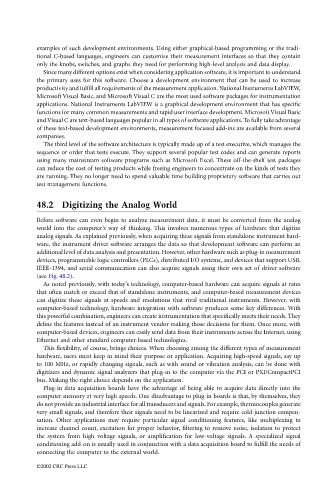Page 1204 - The Mechatronics Handbook
P. 1204
examples of such development environments. Using either graphical-based programming or the tradi-
tional C-based languages, engineers can customize their measurement interfaces so that they contain
only the knobs, switches, and graphs they need for performing high-level analysis and data display.
Since many different options exist when considering application software, it is important to understand
the primary uses for this software. Choose a development environment that can be used to increase
productivity and fulfill all requirements of the measurement application. National Instruments LabVIEW,
Microsoft Visual Basic, and Microsoft Visual C are the most used software packages for instrumentation
applications. National Instruments LabVIEW is a graphical development environment that has specific
functions for many common measurements and rapid user interface development. Microsoft Visual Basic
and Visual C are text-based languages popular in all types of software applications. To fully take advantage
of these text-based development environments, measurement focused add-ins are available from several
companies.
The third level of the software architecture is typically made up of a test executive, which manages the
sequence or order that tests execute. They support several popular test codes and can generate reports
using many mainstream software programs such as Microsoft Excel. These off-the-shelf test packages
can reduce the cost of testing products while freeing engineers to concentrate on the kinds of tests they
are running. They no longer need to spend valuable time building proprietary software that carries out
test management functions.
48.2 Digitizing the Analog World
Before software can even begin to analyze measurement data, it must be converted from the analog
world into the computer’s way of thinking. This involves numerous types of hardware that digitize
analog signals. As explained previously, when acquiring these signals from standalone instrument hard-
ware, the instrument driver software arranges the data so that development software can perform an
additional level of data analysis and presentation. However, other hardware such as plug-in measurement
devices, programmable logic controllers (PLCs), distributed I/O systems, and devices that support USB,
IEEE-1394, and serial communication can also acquire signals using their own set of driver software
(see Fig. 48.2).
As noted previously, with today’s technology, computer-based hardware can acquire signals at rates
that often match or exceed that of standalone instruments, and computer-based measurement devices
can digitize these signals at speeds and resolutions that rival traditional instruments. However, with
computer-based technology, hardware integration with software produces some key differences. With
this powerful combination, engineers can create instrumentation that specifically meets their needs. They
define the features instead of an instrument vendor making those decisions for them. Once more, with
computer-based devices, engineers can easily send data from their instruments across the Internet, using
Ethernet and other standard computer-based technologies.
This flexibility, of course, brings choices. When choosing among the different types of measurement
hardware, users must keep in mind their purpose or application. Acquiring high-speed signals, say up
to 100 MHz, or rapidly changing signals, such as with sound or vibration analysis, can be done with
digitizers and dynamic signal analyzers that plug-in to the computer via the PCI or PXI/CompactPCI
bus. Making the right choice depends on the application.
Plug-in data acquisition boards have the advantage of being able to acquire data directly into the
computer memory at very high speeds. One disadvantage to plug-in boards is that, by themselves, they
do not provide an industrial interface for all transducers and signals. For example, thermocouples generate
very small signals, and therefore their signals need to be linearized and require cold-junction compen-
sation. Other applications may require particular signal conditioning features, like multiplexing to
increase channel count, excitation for proper behavior, filtering to remove noise, isolation to protect
the system from high voltage signals, or amplification for low-voltage signals. A specialized signal
conditioning add-on is usually used in conjunction with a data acquisition board to fulfill the needs of
connecting the computer to the external world.
©2002 CRC Press LLC

